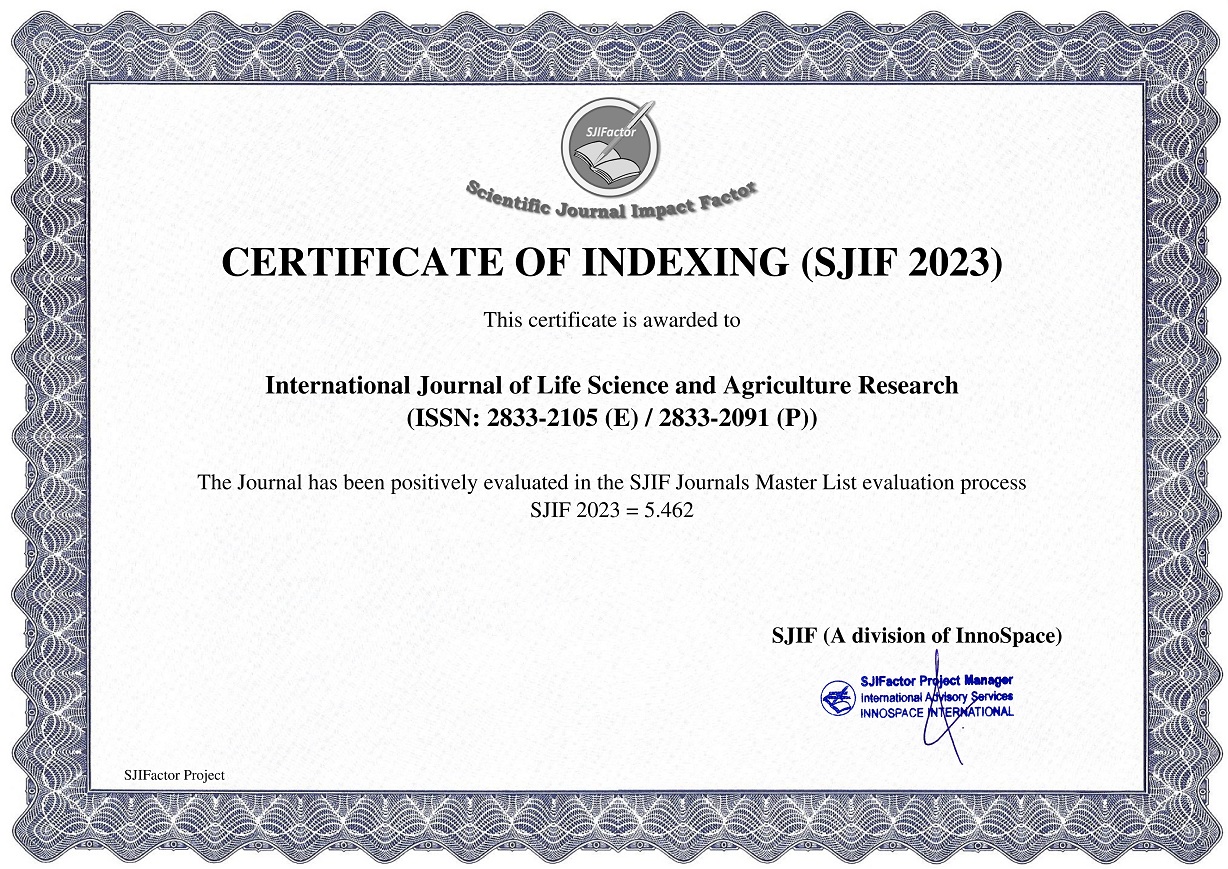Contributions of Climatic Smart Agricultural Practises on Adaptation to Climate Change among Small holder farmers in Nyaribari Chache Sub-County, Kisii County
DOI:
https://doi.org/10.55677/ijlsar/V02I06Y2023-03Keywords:
Mixed cropping, Crop rotation, Extension, Credit, KisiiAbstract
Smallholder farmers are usually susceptible to the effects of climatic variations. Most of these farmers, their agricultural activities are greatly rainfall dependent and compounded by their acute poverty, poor infrastructural and technological advancement. This study sought to assess the contribution of Climate Smart Agricultural strategies on adaptation to climate change among small holder farmers in Nyaribari Chache Sub-County, Kisii County. A household survey was conducted for collection of primary data. Ten administrative sub-locations were randomly sampled for the study. Twenty households were randomly sampled from each sub-location to make a sample size of 200 households. Questionnaires, interviews and focused group discussions were administered to collect data on contributions of Climate Smart Agricultural strategies to adapt to climate change among small holder farmers in Nyaribari Chache Sub-County, Kisii County. Both descriptive and inferential analysis were used to analyze data collected. Study findings indicated that crop diversification, use of different crop cultivars, crop rotation and mixed cropping were the primary adaptation approaches employed in the study area. CSAP Adopted by Smallholder Farmers was statistically significant (p<0.005). Determinants of smallholder farmers’ choice of CSAP on adaptation to climatic variations had a significant impact on embracing of CSAP (p<0.005). Access to credit facilities, inadequate extension facilities, low education levels, scanty weather and climate statistics were main hurdles impacting on implementation of CSAP. Therefore, in order to check the susceptibility of smallholder farmers to effects of weather or climate erraticism and variations, stakeholders should heighten exposure of farmers to extension services and prompt distribution of climate variations data for informed decision making.
References
Addisu, S., Fissha, G., Gediff, B. and Asmelash, Y. (2016). Perception and adaptation models of climate change by the rural people of lake Tana Sub-Basin, Ethiopia. Environ Syst Res.
Adimassu, Z and Kessler, A. (2016) Factors affecting farmers’ coping and adaptation strategies to perceived trends of declining rainfall and crop productivity in the central Rift valley of Ethiopia. Environ Syst Res. 5:1–13.
Akumbole, J. A., Zakaria, H. and Adam, H. (2018). Determinants of adoption of improved maize technology among smallholder maize farmers in the Bawku West District of the Upper East Region of Ghana. Agric Ext J; 2(3):165–75.
Belay, A., Recha, J.W., Woldeamanuel, T. and Morton, J. F. (2017). Smallholder farmers’ adaptation to climate change and determinants of their adaptation decisions in the Central Rift Valley of Ethiopia. Agric Food Secur. 7; 6(1)-21.
Debalke, N. M. (2013). Determinants of farmers’ preference for adaptation strategies to climate change: Evidence from north shoa zone of Amhara region Ethiopia. Munich Pers RePEc Arch.
FAO (2013). Climate-Smart Agriculture Source Book. Food and Agriculture Organization of the United Nations. Sourcebook on Climate-Smart Agriculture, Forestry and Fisheries.
Fox, P., Rockström, J. and Barron, J. (2005). Risk analysis and economic viability of water harvesting for supplemental irrigation in semi-arid Burkina Faso and Kenya. Agric Syst.
Füssel, H.M. (2007). Vulnerability: A generally applicable conceptual framework for climate change research. Glob Environ Chang.
Gbetibouo, G.A. (2009). Understanding farmers’ perceptions and adaptations to climate chang and variability: The case of the Limpopo basin, South Africa. IFPRI Discussion Paper 00849.
GoK (Government of Kenya) (2017). Kenya Climate Smart Agriculture Strategy.
IPCC (2018). An IPCC Special Report on the impacts of global warming of 1.5°C. Intergov Panel Clim Chang.
IPCC (2019). Special Report on Climate Change and Land. Ipcc;
Katharine, V., Cull, T., Chanika, D., Hamazakaza, P., Joubert, A. and Macome, E. (2013). Farmers’responses to climate variability and change in southern Africa - is it coping or adaptation? Clim Dev. 2013; 5(3):194–205.
Kahsay, H. T., Guta, D. D., Birhanu, B.S., Gidey, T.G. and Routray, J. K. (2019). Farmers’ perceptions of climate change trends and adaptation strategies in semiarid highlands of Eastern Tigray, Northern Ethiopia. Adv Meteorol.
Kimani, N.C. and Bhardwaj, S.K. (2015). Assessment of people’s perceptions and adaptations to climate change and variability in mid-hills of Himachal Pradesh, India. Int J. Curr Microbiol Appl Sci. 2015; 4(8):47–60.
Kichamu, E. A., Ziro, J.S., Palaniappan, G. and Ross, H. (2018). Climate change perceptions and adaptations of smallholder farmers in Eastern Kenya. Environ Dev Sustain. 2018; 20 (6):2663–80.
Kisii County Government-(KCG). (2013). The First County Integrated Development Plan; 2013- 2017.
KNBS (Kenya National Bureau of Statistics), (2019). Kenya population and Housing Census.
UNEP (2015). Green Economy Sector study on agriculture in Kenya. Maguza-Tembo, F., Edriss, A. K and Mangisoni, J. (2017). Determinants of climate smart agriculture technology adoption in the drought prone districts of Malawi using a multivariate probit analysis. Asian J Agric Extension, Econ Sociol.
Makate, C., Wang, R., Makate, M. and Mango, N. (2016). Crop diversification and livelihoods of smallholder farmers in Zimbabwe: Adaptive management for environmental change. Springerplus; 2016.
Marenya, P.P. and Barrett, C.B. (2007). Household-level determinants of adoption of improved natural resources management practices among smallholder farmers in western Kenya. Food Policy; 32: 515–36.
Mutunga, E., Ndungu, C. and Muendo, P. (2017). Smallholder farmers’ perceptions and adaptations to climate change and variability in kitui County, Kenya. J. Earth Sci Clim Change; 8(3):1–7
Mutunga, E., Ndungu, C, Muendo, P. (2018). Factors influencing smallholder farmers’ adaptation to climate variability in Kitui County, Kenya. Int J Environ Sci Nat Resour; 8(5):155–61.
Nhemachena, C. and Hassan, R. (2007). Micro-Level Analysis of Farmers Adaption to climate change in Southern Africa booksgooglecom.
Ochieng, J., Kirimi, L. and Makau, J. (2017). Adapting to climate variability and change in rural Kenya: farmer perceptions, strategies and climate trends. Nat Resour Forum; 41:195–208
Shilenje, Z. W., Ogwang, B. A. (2015). The Role of Kenya Meteorological Service in Weather Early Warning in Kenya. Int J Atmos Sci.
Syngenta (2014). Agricultural Extension, Improving the livelihood of smallholder farmers.
Wamalwa, I. W., Mburu, B.K. and Mang’uriu, D.G. (2016). Perception of climate change effects and its influence on uptake of climate smart practices among small scale farmers of Kisii County, Kenya. Int J. Inf Res Rev. 3(5):2409-2417.





